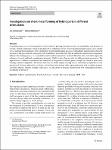Item Infomation
Full metadata record
| DC Field | Value | Language |
|---|---|---|
| dc.contributor.author | Jan, Hafenecker | - |
| dc.contributor.author | Marion, Merklein | - |
| dc.date.accessioned | 2023-05-25T01:29:54Z | - |
| dc.date.available | 2023-05-25T01:29:54Z | - |
| dc.date.issued | 2022 | - |
| dc.identifier.uri | https://link.springer.com/article/10.1007/s11740-022-01171-6 | - |
| dc.identifier.uri | https://dlib.phenikaa-uni.edu.vn/handle/PNK/8501 | - |
| dc.description | CC BY | vi |
| dc.description.abstract | Conventional processes are being pushed to their limits by growing demands in terms of sustainability and diversity of variants. Hybrid components, which are produced by a combination of two or more manufacturing processes, are a suitable way of meeting these challenges. The combination of sheet metal forming processes with additive manufacturing offers the potential to link personalized components with standardized parts. Knowing that the additively manufactured components influence the forming process, it is essential to understand the interactions in detail. Therefore, this work will compare the influence of several additively manufactured elements (AME) for deep drawing with two different punch geometries. The approach used combines experimental and numerical investigations to improve process insight in relation to sheet metal forming of hybrid components. | vi |
| dc.language.iso | vi | vi |
| dc.publisher | Springer | vi |
| dc.subject | sheet metal forming of hybrid parts | vi |
| dc.title | Investigations on sheet metal forming of hybrid parts in different stress states | vi |
| dc.type | Book | vi |
| Appears in Collections | ||
| OER - Kỹ thuật điện; Điện tử - Viễn thông | ||
Files in This Item:

